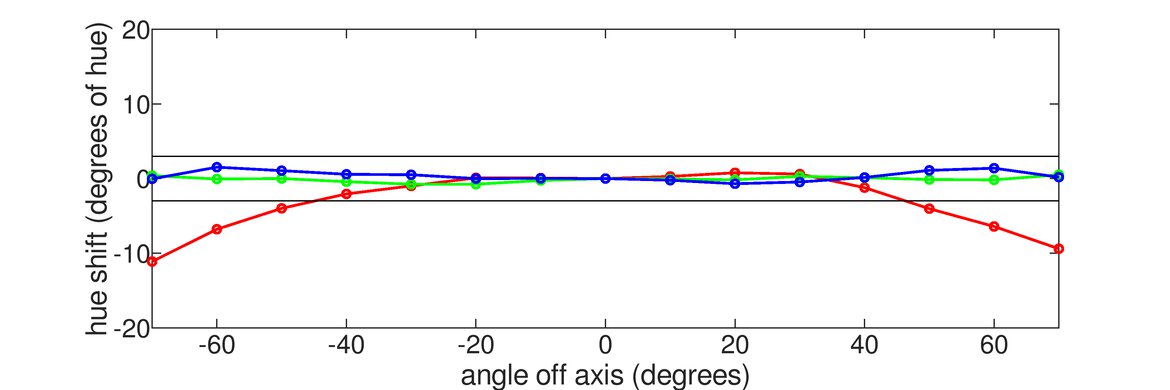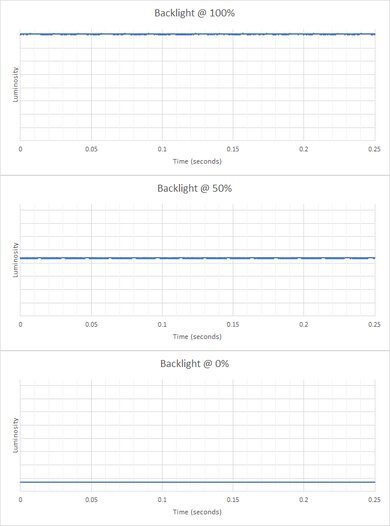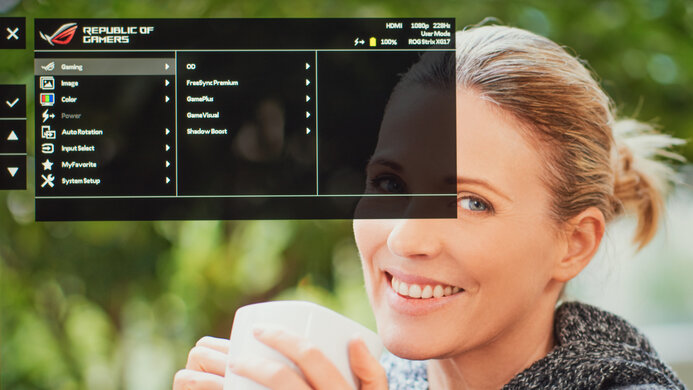The ASUS ROG Strix XG17AHPE is a decent monitor overall and by far the best portable monitor we've tested. It's great for gaming, with a high refresh rate, excellent response times, low input lag, and variable refresh rate (VRR) support. The built-in battery gives about 3 hours of game time, and its compact size will easily fit into most laptop bags. As expected for a portable monitor, the stand on this version isn't very versatile, resulting in bad ergonomics. It's also available with a compact tripod mount, although we haven't tested that version, or you can mount it to any standard camera mount, which is a bit unusual for a monitor, but it works. The relatively small size of this monitor coupled with the 1080p resolution results in great text clarity, making this a decent choice for a portable office monitor as well. Unfortunately, it might not be bright enough to overcome glare, and like all IPS monitors we've tested, blacks look gray in a dark room.
Our Verdict
The ASUS ROG Strix XG17AHPE is a decent monitor for most uses. The high refresh rate and fast response times make it a great choice for gaming on the go. Due to the small size, it's a decent companion monitor for mobile office use as well, especially if you're working from a laptop and need a bit more screen real estate. It's also an okay choice for multimedia or media creation, but the small size makes it best-suited for quick edits.
- 7800mAh battery is great for portability.
- Great gaming performance.
- Okay viewing angles.
- Disappointing black uniformity.
- Blacks look gray in a dark room.
- Might not be bright enough to overcome glare.
The ASUS XG17AHPE is a decent portable office monitor. The small size isn't the best choice for full-time work, but it's a good choice for quick edits or a secondary display for more screen space. The relatively high pixel density results in great text clarity, and it has excellent gray uniformity. Unfortunately, the unit we bought has disappointing black uniformity, and it might not be bright enough to overcome glare in a bright room.
- Excellent gray uniformity.
- 7800mAh battery is great for portability.
- Okay viewing angles.
- Disappointing black uniformity.
- Blacks look gray in a dark room.
- Might not be bright enough to overcome glare.
The ASUS XG17 is a great gaming monitor. The high refresh rate results in excellent response times, so fast-moving objects are clear with little blur, and it has low input lag for a responsive gaming experience. It also supports variable refresh rate technology (VRR), for a nearly tear-free gaming experience. It's not bright enough for gaming outside, but for a quick gaming session away from home, it's a great choice.
- Outstanding response time.
- Low input lag.
- 7800mAh battery is great for portability.
- Okay viewing angles.
- Disappointing black uniformity.
- Blacks look gray in a dark room.
- Might not be bright enough to overcome glare.
The ASUS ROG Strix XG17AHP is okay for multimedia. It has low input lag and excellent gray uniformity, and the viewing angles are okay. The small size isn't great for watching movies, and it doesn't support HDR. It's not the most versatile monitor, as it might not be bright enough to overcome glare in a bright room. It has a low contrast ratio and disappointing black uniformity, so it's best suited for a medium-lit room with no direct light.
- Excellent gray uniformity.
- 7800mAh battery is great for portability.
- Okay viewing angles.
- Disappointing black uniformity.
- Blacks look gray in a dark room.
- Might not be bright enough to overcome glare.
The ASUS XG17 is just okay for media creation. It has great gradient handling and excellent uniformity, and it has nearly perfect coverage of the sRGB color space. On the other hand, the relatively small screen isn't ideal for full-time work but can be handy for a quick edit, and it's not bright enough to overcome glare in a bright room.
- Low input lag.
- Excellent gray uniformity.
- 7800mAh battery is great for portability.
- Okay viewing angles.
- Disappointing black uniformity.
- Blacks look gray in a dark room.
- Might not be bright enough to overcome glare.
This monitor doesn't support HDR.
Changelog
- Updated Jul 04, 2022: There was a mistake in the 60Hz input lag results. We remeasured the input lag at 60Hz, and it's 0.6ms higher than our original results.
- Updated Aug 06, 2021: We updated the pixel photo as it was incorrectly cropped.
- Updated Jun 15, 2021: Review published.
- Updated Jun 11, 2021: Early access published.
Check Price
Differences Between Sizes And Variants
We tested the 17 inch ASUS ROG Strix XG17AHPE. It's also available in a 16 inch size, known as the ASUS ROG Strix XG16AHPE, but there are some differences between them. There's also an alternate model known as the ASUS ROG Strix XG17AHP. We expect the alternate model to perform the same, but it includes a tripod stand.
| Model | Size | Native Resolution | Max Refresh rate | Panel Type | Notes |
|---|---|---|---|---|---|
| XG17AHP | 17" | 1080p | 240Hz | IPS | Includes tripod stand |
| XG17AHPE | 17" | 1080p | 240Hz | IPS | Folio stand |
If you come across a different type of panel, or your ASUS XG17 doesn't correspond to our review, let us know, and we'll update the review. Note that some tests, like gray uniformity, may vary between individual units.
Our unit was manufactured in January 2021. You can see our unit's label here.
Popular Monitor Comparisons
The ASUS XG17 is a great portable gaming monitor, but it comes with a premium price tag. It's far better than the other portable monitors we've tested, like the MSI Optix MAG161V, but it targets a very specific audience, as it's not for everyone.
For more options, check our picks for the best budget monitors, the best USB-C monitors, and the best office monitors.
The ASUS ROG Strix XG17AHPE is much better than the Lepow Z1. The ASUS has much faster response times, resulting in clear motion with little blur behind fast-moving objects, and it supports Adaptive Sync variable refresh rate technology (VRR), making it a much better gaming monitor. The ASUS has a built-in battery, and it delivers better picture quality, with a significantly better color gamut, and better accuracy, even after calibration.
The ASUS ROG Strix XG17AHPE is much better than the ASUS ZenScreen MB14AC. The ROG delivers much better gaming performance, with a significantly faster refresh rate, better response times, and lower input lag. The ROG also has much better picture quality, with a wider SDR color gamut and better accuracy out of the box. The ROG also has a slightly larger screen and a built-in battery.
The ASUS VG279QM and the ASUS ROG Strix XG17AHPE are very different monitors that target different needs. The XG17AHPE is a portable gaming monitor. It delivers similar response times to the VG279QM, as well as similar input lag. Due to the portable nature of the XG17AHPE, though, it has terrible ergonomics and a much smaller screen. The VG279QM is a desktop gaming monitor with a larger screen, better viewing angles, and HDR support.
The ASUS ROG Strix XG17AHPE and the MSI Optix MAG274QRF-QD are very different monitors, each with strengths and weaknesses. The ASUS is designed for portability, so it has a smaller screen, much worse ergonomics, and slightly worse viewing angles. The MSI is more feature-rich, as it supports HDR and has an optional black frame insertion feature.

We buy and test more than 30 monitors each year, with units that we buy completely on our own, without any cherry-picked units or samples. We put a lot into each unbiased, straight-to-the-point review, and there's a whole process from purchasing to publishing, involving multiple teams and people. We do more than just use the monitor for a week; we use specialized and custom tools to measure various aspects with objective data-based results. We also consider multiple factors before making any recommendations, including the monitor's cost, its performance against the competition, and whether or not it's easy to find.
Test Results

The ASUS ROG Strix XG17 has a sleek design with thin bezels and excellent build quality. The folio stand isn't the most flexible, so ergonomics might be an issue for some people. That said, there's an available tripod mount that should have excellent ergonomics if you care about that, but we haven't tested it. You can also mount it to any standard camera tripod. This is an unusual but useful feature.
As expected for a portable monitor, the ergonomics are terrible. You can display the ASUS XG17AHPE in a portrait or landscape orientation, and there's an auto-rotate feature that can detect when it's in portrait mode and request that the source rotates as well. Note that this feature is only supported on Windows PCs and requires a special driver.
If you need better ergonomics, you can also buy this monitor in a bundle, known as the ASUS ROG Strix XG17AHP, which comes with an ASUS tripod stand, which we expect to have excellent ergonomics.
The back is plain, except for the ASUS Republic of Gamers logo, which is also an RGB light. The RGB light turns off automatically when the display is running on battery power, which is nice. As expected for a portable monitor, there's no cable management. It can't be VESA mounted, but there's a mounting hole on the back that fits a standard 1/4" camera mount, similar to the ASUS ZenScreen MB14AC.
The ASUS XG17AHPE has excellent build quality. The frame is entirely metal, and there's very little flex to the body, which is surprising for its size. The case feels well-built as well, and the magnetic attachments snap into place easily and feel secure. The only potential issue we noticed is with the HDMI and USB-C ports. They seem a bit loose, and cables tended to move around a bit when connected.
The ASUS ROG Strix XG17 has passable contrast, which we expect for an IPS panel. This results in blacks that tend to look gray in a dark room. ASUS advertises a typical contrast ratio for this monitor of about 1000:1, so this is slightly above advertised, but this can vary with units.
The ASUS ROG Strix XG17AHP doesn't have a local dimming feature. The video is for reference only, so you can see how the local dimming feature on other displays compares to one without local dimming.
The ASUS ROG STRIX XG17 has decent peak brightness in SDR. There's no variation in peak brightness with different content (ABL), which is great. Unfortunately, it's not bright enough to overcome direct sunlight.
Note that we measured the peak brightness after calibration in the 'User' Picture Mode, with the brightness set to max.
The ASUS XG17AHP doesn't support HDR.
The ASUS XG17 has okay horizontal viewing angles. Shifting off center, colors wash out at a narrow angle, and brightness decreases quickly, causing the image to appear darker.
The ASUS XG17AHP has adequate vertical viewing angles. Colors quickly fade when moving off-center. It's fine for most users but not ideal for sharing the screen with someone standing beside you, for example.
This monitor has excellent gray uniformity. The sides of the screen are slightly darker than the center, but it's not very noticeable with regular content. There's very little dirty screen effect in the center, which is great. In near-dark scenes, the uniformity is even better. Note that this can vary a bit between units.
Unfortunately, the unit we bought has disappointing black uniformity. There's significant clouding throughout the screen and a few very bright spots on the screen that can be distracting in dark scenes. This varies between units, so let us know if you get one that's better than this.
ASUS does a partial calibration at the factory, and the one we bought has great accuracy out of the box, but this can vary between units. The color temperature is a bit cold, giving everything a slightly bluish tint, and the white balance is inaccurate, but not noticeably so. Except for pure blue, colors are displayed accurately, with no other noticeable issues. Gamma is the biggest issue, as it doesn't follow the sRGB target curve, and most scenes are brighter than they should be.
This was measured in the sRGB picture mode, which is the most accurate mode on this monitor. In this mode, the saturation, color temperature, sharpness, brightness, and contrast are locked and can't be adjusted.
This monitor has outstanding accuracy after calibration. Gamma follows the sRGB target curve almost perfectly, and there are almost no remaining issues with the white balance. Colors are almost perfect, except for highly saturated blues, which are still inaccurate and could cause issues for some users.
You can download our ICC profile calibration here. This is provided for reference only and shouldn't be used, as the calibration values vary per individual unit due to manufacturing tolerances, even for the same model.
This monitor has an amazing SDR color gamut. It can display the entire sRGB color space used by most content. Coverage of the wider Adobe RGB color space is very good, but it can't display the full range of greens and blues, which may disappoint content creators.
The ASUS ROG Strix XG17AHP has outstanding SDR color volume. Thanks to the wide color gamut, it can display the full range of sRGB colors at most brightness levels, but like most LCDs, blues aren't as bright as pure white. Also, due to the low contrast ratio, it can't display dark, saturated colors very well.
The ASUS XG17AHP doesn't support HDR.
The ASUS XG17AHPE doesn't support HDR.
The ASUS XG17AHP has great gradient handling, but it's not as good as the Lepow Z1. As this monitor can only accept 8-bit signals, there's noticeable 8-bit banding throughout the screen, but otherwise, it's pretty good.
| Overdrive Level | Response Time Chart | Response Time Tables | Motion Blur Photo |
| 0 | Chart | Table | Photo |
| 1 | Chart | Table | Photo |
| 2 | Chart | Table | Photo |
| 3 | Chart | Table | Photo |
| 4 | Chart | Table | Photo |
| 5 | Chart | Table | Photo |
The ASUS ROG Strix XG17AHPE has outstanding response times at the max refresh rate, far better than any other portable monitor we've tested so far. At our recommended overdrive setting of 'Level 3' there's no overshoot and almost no noticeable blur behind fast-moving objects. The higher overdrive levels are slightly faster, but there's also some noticeable overshoot, especially in brighter scenes. They're still very useable, though, so you should choose whichever one you feel looks best.
| Overdrive Level | Response Time Chart | Response Time Tables | Motion Blur Photo |
| 0 | Chart | Table | Photo |
| 1 | Chart | Table | Photo |
| 2 | Chart | Table | Photo |
| 3 | Chart | Table | Photo |
| 4 | Chart | Table | Photo |
| 5 | Chart | Table | Photo |
The 60Hz response times of this monitor are excellent, almost as fast as at the max refresh rate. Unlike at the max refresh rate, though, we don't recommend anything higher than the 'Level 0' overdrive setting, which means you'll need to switch settings when changing to a 60Hz source, like some game consoles.
This monitor doesn't have an optional Black Frame Insertion feature (BFI).
The ASUS ROG Strix XG17 has an extremely fast refresh rate, and it supports Adaptive Sync and FreeSync variable refresh rate technology (VRR), which can help reduce screen-tearing. Although not officially certified, it also supports NVIDIA's G-SYNC Compatible mode, but only over USB-C. Thanks to the low resolution, the full refresh rate range is available over HDMI and USB-C.
This monitor has outstanding low input lag, resulting in a very responsive gaming experience. The input lag with variable refresh rate (VRR) enabled is slightly higher than usual, but it's not a very noticeable difference.
There are two USB-C ports, but one of them is only for charging. One of the ports supports DP Alt Mode, so it can be connected to a DisplayPort output using a USB-C to DisplayPort adapter cable (not included).
The ASUS ROG Strix XG17AHPE has a great selection of additional features, including:
- Built-in ESS 9118 digital-to-analog converter: Audio processor that can push 24-bit/192kHz lossless playback.
- 7800 mAh battery: ASUS advertises a battery life of up to 3.5 hours. We don't usually test this, but in a quick test we measured a battery life of about 2.8 hours. This was done by watching videos with the refresh rate set to 240Hz, and the backlight set to about 200 cd/m². At lower brightness settings or a lower refresh rate, the battery likely lasts longer than advertised.
- Stereo speakers: We don't measure the frequency response for monitors, but subjectively, these sound surprisingly good for a portable device. They're quite loud, and the sound is crisp, and clear.
- GamePlus: A set of virtual overlays for gamers, including a virtual crosshair, framerate counter, and timer.













































